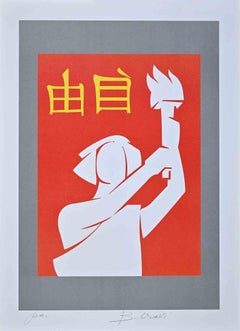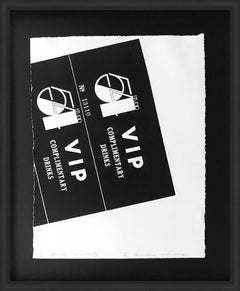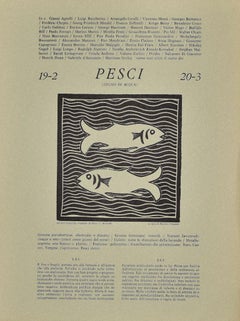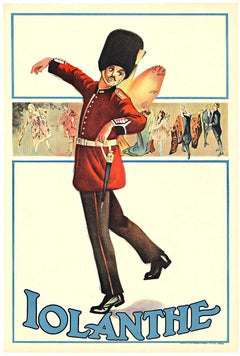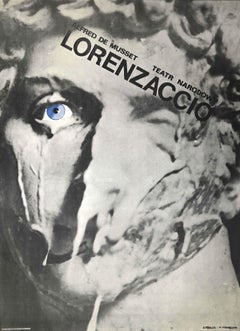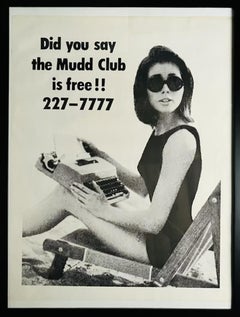Poster Figurative Prints
to
378
482
181
292
323
155
Overall Width
to
Overall Height
to
443
258
194
91
28
23
23
23
10
9
3
1
23
15
15
13
13
101
1,137
195
19
66
55
75
62
97
98
260
143
49
1,251
127
53
26,973
14,787
10,582
9,093
7,790
7,003
4,603
4,164
2,410
2,046
1,929
1,865
1,661
1,470
1,465
1,444
1,433
1,299
1,225
1,106
561
404
231
205
153
112
600
723
548
Art Subject: Poster
Liberty - Lithograph by Bettino Craxi - 1989
Located in Roma, IT
Liberty is an original lithograph on paper realized by the Italian politician Bettino Craxi in 1989.
Original lithograph on paper.
Hand-signed in pencil on the lower right corner...
Category
1980s Modern Figurative Prints
Materials
Lithograph
STUDIO 54 COMPLIMENTARY DRINKS FS IIIA.16A
By Andy Warhol
Located in Aventura, FL
Screenprint in black on wove paper, hand signed and inscribed 'to Camilla and Earl' by the artist. From the edition of 20. Sheet size 25.25 x 19.25 inches. Custom framed as pictu...
Category
1970s Pop Art Figurative Prints
Materials
Screen, Paper
The Two Fishes - Original Woodcut by P. C. Antinori - 20th Century
Located in Roma, IT
Zodiac Signs - The Two Fish is original Black and white woodcut, realized by Italian artist Piero C. Antinori.
Excellent condition.
Written on the lower left; Original woodcut of P...
Category
20th Century Contemporary Figurative Prints
Materials
Woodcut
Original "Iolanthe" vintage stone lithograph vintage theater poster
Located in Spokane, WA
Original Iolanthe vintage theatre poster: Gilbert and Sullivan Iolante stone lithograph vintage poster. Museum linen backed. Clear, clean, bright. Grade A condition.
The poster features a central image of a character dressed in a traditional British Grenadier Guard uniform, complete with a bearskin hat. The character is depicted in a whimsical pose, which aligns with the comedic and satirical nature of the operetta. Above the main figure, there are smaller illustrations of various characters from the operetta, hinting at the fantastical and fairy-tale elements of the story. The title "Iolanthe" is prominently displayed in bold, stylized lettering at the bottom.
"Iolanthe, or The Peer and the Peri," is a comic opera by the famous duo W.S. Gilbert and Arthur Sullivan. The opera premiered on November 25, 1882, at the Savoy Theatre in London and is one of their most beloved works.
"Iolanthe" tells the story of fairy Iolanthe, who was banished from the fairy kingdom...
Category
1920s Art Nouveau Portrait Prints
Materials
Lithograph
$268 Sale Price
20% Off
National Theatre - Vintage Poster by A. Krauze and M. Mroszczak - 1975
Located in Roma, IT
National Theatre is an original poster realized by A.Krauze and M.Mroszczak (Katowice, 1950) in 1975s.
Good condition.
Hand-signed.
Andrzej Krauze (born 7 March 1947) is a Polish-...
Category
1970s Contemporary Figurative Prints
Materials
Paper, Offset
Mudd Club New York 1979 street poster (framed)
Located in NEW YORK, NY
Original Mudd Club poster, New York 1979:
A must have for any true Jean Michel Basquiat, Keith Haring collector - this piece is featured in the 2017 Jean-Michel Basquiat documentary, 'Boom For Real.'
Promotional poster. 1979.
Artwork Dimensions: 18x24 inches (19x25 inches).
Very good overall vintage condition condition; some minor fading consistent with age. Minor wear to frame.
Provenance: Obtained directly from the original art designer.
The Mudd Club was founded by filmmaker Steve Mass, art curator Diego Cortez, and downtown punk scene figure Anya Phillips...
Category
1970s Pop Art Prints and Multiples
Materials
Lithograph, Screen
$700 Sale Price
20% Off
Keith Haring Milan c.1989 (vintage Keith Haring)
Located in NEW YORK, NY
Keith Haring Milan c.1989
Rare vintage Milan exhibition announcement circa late 1980’s featuring offset printed artwork by Keith Haring. Uniquely rendere...
Category
1980s Pop Art Prints and Multiples
Materials
Offset, Lithograph, Paper
Art Deco Folies Bergere La Grande Folie Lithograph Poster
Located in New York, NY
Add a piece of Parisian glamour to your collection with this Art Deco "Folies Bergere La Grande Folie" Lithograph Poster Print from France, circa 1927. This striking poster captures ...
Category
1920s Figurative Prints
Materials
Lithograph
'Eddie Diptych', Signed Pop Art Exhibition Poster, Guggenheim, Venice Biennale
Located in Santa Cruz, CA
Vintage, 1986, Walker Art Center exhibition poster; signed, lower right, in pencil, 'R. Lichtenstein' for Roy Lichtenstein (American, 1923-1997) and accompanied by certificate of aut...
Category
1980s Figurative Prints
Materials
Paper, Offset
Bartolomeo Pinelli Vintage Exhibition Poster - 1983
Located in Roma, IT
Bartolomeo Pinelli vintage exhibition poster is an original poster of the exhibition held in 1983 at Rondanini Gallery in Rome, Italy.
Very good conditions.
Bartolomeo Pinelli (Rom...
Category
1980s Figurative Prints
Materials
Paper, Offset
Poster after Simbari - New York - Offset - 1970
Located in Roma, IT
Manifest of Simbari i is a vintage offset and lithograph realized by Nicola Simbari in 1970.
Hand-signed on the bottom center.
The artwork represents a woman and two girls playi...
Category
1970s Contemporary Figurative Prints
Materials
Offset
$177 Sale Price
25% Off
"Dolly (I Love you!), " Original Color Lithograph Poster by the Clérice Frères
Located in Milwaukee, WI
"Dolly" is an original color lithograph poster by The Clérice Frères (The Clérice Brothers), signed within the composition on the lower left edge, just ...
Category
1920s Art Deco Figurative Prints
Materials
Lithograph
PKZ [Man Tipping His Hat].
By Franco Barberis
Located in New York, NY
Barberis, Franco. PKZ [Man Tipping His Hat]. 1953, Color lithograph, 50 1/2 x 35 1/2”
On Linen. Ref: American Poster Renaissance, p. 41
As a graphic designer, Barberis was initial...
Category
1940s Art Deco Figurative Prints
Materials
Lithograph
Peter Pathe - Original Lithograph Poster
Located in Palm Beach, FL
PETER PATHE, poster lithograph, Schnackenberg School, 1919, the image features the headline performer, Peter Pathe, in drag wearing a form-fitting button-down jacket, high-waisted shorts buttoning down the front, Mary Jane dance shoes and calf-length white socks; Pathe is depicted in motion with raised jazz hands which frame his bushy-haired heavily made-up face and body curving in dynamic lateral movement with raised front leg turned out; with printed text at the bottom: “PETER PATHE/und/Fritz Wolf-Killanyi * Renate Ferena/Tia Majja * Else Zimmermann tanzenmit grossem/Orchester (Leitung: Rob. Tants) Donnerstag, 18 Nov., amends 71/2 Uhr im Konzertsaal Hotel “Vier Jahreszeiten”/Karten zu Mk. 20. - bis Mk. 3.- bei Alfr. Schmid Nachf., Residenzstr. 7 und Otto Halbreiter, Promendeplatz 16.”; printed text at mid-right: “M. Pathe/19”; marked with the printer’s stamp in the lower right: “Oscar Consee/Kunstanstalt/Munchen/Valley Str./7-9”; the poster is secured by matting and framed with a plexiglass cover, Boston...
Category
1910s Art Nouveau Figurative Prints
Materials
Lithograph
BLACKGLAMA (JUDY GARLAND) FS II.351
By Andy Warhol
Located in Aventura, FL
From the "ADS" portfolio. Screen print on lenox museum board Hand signed and numbered by the artist. Edition PP 5/5 (There is a main edition of Edition of 190, 30 AP, 5 PP, 5 EP, 1...
Category
1980s Pop Art Figurative Prints
Materials
Board, Screen
Original Andy Warhol Double Self Portrait - Louisiana (Denmark) vintage poster
By Andy Warhol
Located in Spokane, WA
Andy Warhol, Double Self-Portrait — Louisiana Museum, 1978
Original Danish exhibition poster; linen-backed; Very Fine (Grade A)
Striking vintage exhibition poster created by the Lo...
Category
1970s Pop Art Portrait Prints
Materials
Offset
Original 1920 Michaels Hustru- Michaels Wife vintage Swedish silent movie poster
Located in Spokane, WA
Original Vintage Movie Poster: The Woman Michael Married (1919) - Starring Bessie Barriscale (Michaels Hustru). Archival linen backing and ready for framing. Theater fold marks resto...
Category
1920s Art Deco Portrait Prints
Materials
Lithograph
'Babylone d'Allemagne' original lithograph poster by Henri de Toulouse-Lautrec
Located in Milwaukee, WI
'Babylone d'Allemagne' or 'German Babylon' is an original lithograph poster by the lauded artist of the Art Nouveau style Henri de Toulouse-Lautrec. This is the second poster that La...
Category
1890s Art Nouveau Portrait Prints
Materials
Paper, Lithograph
Travel Freely- Bewegungsfrei reisen
Located in Brooklyn, NY
This original vintage German travel poster, titled Travel Freely (Bewegungsfrei reisen), was designed by Hermann Rastorfer for the Deutsche Bundesbahn and issued by the Bundesbahn We...
Category
1960s Modern Figurative Prints
Materials
Offset
Raymond Pettibon Black Flag poster (Raymond Pettibon punk)
Located in NEW YORK, NY
Raymond Pettibon Black Flag poster circa 1983:
Flea, the Red Hot Chili Peppers bassist once said of Pettibon's Black Flag illustrations and iconic l...
Category
1980s Street Art Prints and Multiples
Materials
Lithograph, Offset
$500 Sale Price
20% Off
Poppies Have Pockets..., Pop Art Screenprint by John Giorno
By John Giorno
Located in Long Island City, NY
Artist: John Giorno
Title: Poppies Have Pockets Packed With Narcotic Treats
Portfolio: Welcoming the Flowers
Date: 2007
Screenprint, signed, numbered, and dated in pencil
Edition of ...
Category
Early 2000s Pop Art Figurative Prints
Materials
Screen
"Speedway" large French movie poster with Elvis Presley, Nancy Sinatra
Located in Milwaukee, WI
This poster for the 1968 film Speedway is an energetic and playful work of graphic design. The poster is dominated by vibrant magenta and yellow, making the image of Elvis Presley an...
Category
1960s Modern Figurative Prints
Materials
Lithograph
Musee D'Art Moderne Paris 1993 Poster, Niki de Saint Phalle
Located in Dubai, Dubai
Musee D'Art Moderne Paris 1993
Serigraph poster
after Niki de Saint Phalle
Niki de Saint Phalle was a French-American artist and sculptor known for her bold, large-scale works, inc...
Category
1990s Contemporary Figurative Prints
Materials
Screen
Keith Haring 1989 UNICEF poster (vintage 1980s Keith Haring poster)
By Keith Haring
Located in NEW YORK, NY
Keith Haring USA Celebrates UNICEF, 1989 (Keith Haring UNICEF 1989):
RARE original 1980s Keith Haring illustrated benefit poster for UNICEF.
Keith Haring began working with UNICEF in 1985 when he famously organized, 'Rain Dance' - a then, benefit for UNICEF’s African Emergency Relief Fund. A seldom available Keith Haring activist poster that is not to be passed upon.
Medium: Offset lithograph in colors on smooth wove paper. 1989.
Dimensions: 17.5 x 22 inches
Fair to Good overall vintage condition. Contains fold-lines as originally issued; minor signs of handling & age related wear; small tear & loss to upper edge; surface residue in a few areas. Stored & will be shipped flat.
Printed signature, ‘K. Haring 1989’ on the mid right from an edition of unknown. Rarely comes to market.
Literature / References:
Keith Haring: Posters (Jürgen and Osten).
“UNICEF was founded after World War II to bring help and hope to all children at risk or in need – no matter which country they lived in or what role that country played in the war. Our mission is no less urgent and universal today,” said UNICEF Executive Director Anthony Lake. “With so many children around the world in so much need, we are recommitting ourselves to delivering results for every child.”
The organization was established by the United Nations General Assembly to help children in post-war Europe, China and the Middle East. Funded entirely through voluntary contributions from governments, civil society, the private sector and concerned citizens, it rapidly expanded its reach and by 1955 was working for children in more than 90 countries.
Today, UNICEF is the world’s largest children’s organization, working with partners in 190 countries and territories and through the efforts of 13,000 national and international staff to reach every child.
Related Categories:
Keith Haring figurative drawings. Keith Haring activist posters. Keith Haring Dancers. Street art. Graffiti. 1980s. Keith Haring Larry Levan. Keith Haring Paradise Garage...
Category
1980s Pop Art Figurative Prints
Materials
Lithograph, Offset
Original "The Big Show" vintage US 1-sheet movie poster 1961
Located in Spokane, WA
Original "The Big Show", US 1-sheet linen-backed movie poster from 1961. Very fine condition. Professional restoration of original theater fold marks. A - A- condition, ready to frame.
Original "the Big Show" US 1-sheet, 1961, linen-backed vintage movie poster. Very fine condition with the restoration of original theater-issued fold marks. A - A- condition.
NSS 61/125. Ester Williams...
Category
1960s American Modern Animal Prints
Materials
Offset
$479 Sale Price
20% Off
The Hartley Elegies: The Berlin Series- KvF II, Screenprint by Robert Indiana
Located in Long Island City, NY
Artist: Robert Indiana
Title: The Hartley Elegies: The Berlin Series- KvF II
Year: 1990
Medium: Serigraph on Saunders Watercolor paper, signed and numbered in pencil
Edition: 50
P...
Category
1990s Pop Art Figurative Prints
Materials
Screen
Original David Grahams Seger (Victory) 1924 Swedish silent movie poster
Located in Spokane, WA
Original 1924 "David Grahams Seger" Swedish Silent Movie Poster, also called Little Church Around the Corner. This silent film poster is professionally linen-backed in very fine con...
Category
1920s Art Deco Figurative Prints
Materials
Lithograph
"Give Us This Day Our Daily Bread" Original 1899 Lithograph by Alphonse Mucha
Located in Palm Beach, FL
Alphonse Mucha worked mainly as a poster artist and became an influential figure of Art Nouveau in late 1890s, when poster illustrations were emerging as popular art form and new pri...
Category
1890s Art Nouveau Figurative Prints
Materials
Lithograph
SCULTURE - VETRO - DEDICATA AL MAESTRI DEL VETRO DI MURANO ROBERT WILLSON
Located in New York, NY
Robert Willson
SCULTURE - VETRO - DEDICATA AL MAESTRI DEL VETRO DI MURANO ROBERT WILLSON, 1964
Offset lithograph on wove paper
27 1/2 × 20 1/2 inches
Un...
Category
1960s Contemporary Figurative Prints
Materials
Lithograph, Offset
Au Concert
Located in Palm Beach, FL
Commissioned by The Ault & Wiborg Co., USA. Color Zincograph on wove paper, 1896. Hand-signed in black crayon. Wittrock C (of C) edition.
Reference: Wittrock; P28, vol. 2 pg 810.
...
Category
1890s Art Nouveau Figurative Prints
Materials
Paper
Galerie Jorgen, L'Atelier Mourlot by Pablo Picasso
Located in New York, NY
This lithographic poster was printed in 1984 at the Atelier Mourlot in Paris. It is based on a 1947 lithograph entitled La Femme au Fauteuil. The image was composed of six colors, an...
Category
1980s Figurative Prints
Materials
Lithograph
Kostume, Plakate, und Dekorationen, "Odeon-Casino"
Located in Palm Beach, FL
Walter Schnackenberg’s style changed several times during his long and successful career. Having studied in Munich, the artist traveled often to Paris where he fell under the spell of the Henri de Toulouse-Lautrec’s colorful and sensuous posters depicting theatrical and decadent subjects. Schnackenberg became a regular contributor of similar compositions to the German magazines Jugend and Simplicissimus before devoting himself to the design of stage scenery and costumes. In the artist’s theatrical work, his mastery of form, ornamentation, and Orientalism became increasingly evident. He excelled at combining fluid Art Nouveau outlines, with spiky Expressionist passages, and the postures and patterns of the mysterious East.
In his later years, Schnackenberg explored the unconscious, using surreal subject matter and paler colors that plainly portrayed dreams and visions, some imbued with political connotations. His drawings, illustrations, folio prints, and posters are highly sought today for their exceedingly imaginative qualities, enchanting subject matter, and arresting use of color.
SCHNACKENBERG: KOSTUME, PLAKATE UND DEKORATIONEN, a cardboard bound art book consisting of 43 prints of work by Walter Schnackenberg, 30 of which are color lithographs that are signed and some are titled and dated in the plate, as well as black and white prints and photographs with accompanying text by Oskar Bie; lithographs printed at Kunstanstalt Oskar Consee in Munich, other images printed by Gesellschaft Pick & Co. in Munich, the text and cover with color images by Schnackenberg front and verso printed by R. Oldenbourg in Munich; published by Musarion Verlag, Munich, 1920.
The majority of Walter Schnackenberg’s artistic output was destroyed by bomb attacks in Munich in 1944. The highly publicized 2013 auction in New York of the recovered pre-war poster collection once belonging to German poster aficionado, Hans Sachs has reintroduced the world to Walter Schnackenberg’s graphic genius and priceless ephemeral art from a lost era. Besides the museum world, designer Karl Lagerfeld is one of the most prodigious collectors of Schnackenberg. Flipping through the pages of Kostume, Plakate und Dekorationen, it becomes quite clear that Schnackenberg’s collection is ground zero at the crossroads of early modern fashion where the cult of celebrity meets up with dance, music, theater and cabaret, film and the graphic medium. Berlin and Munich under Germany’s Weimar Republic in the first quarter of the 20th century produced just the atmosphere to feed this burgeoning industry. Rising inflation sparked a recklessness to live large for the moment and heightened a desire for escapism. An influx of Indian and East Asian dancers and musicians added to the artsy bohemian cultural mix. A new decadence and tolerance resulted. Film boldly featured provocative subject matter. Cabarets became popular venues giving rise to the demi-monde in which people from all social stations mixed more freely in a thriving underground economy and culture where there was a blurring of boundaries and of social codes. Noted art historian and cultural doyen, Oskar Bie astutely observes in his introduction to Schnackenberg’s publication that what unites the images is fantasy and advertisement. Schnackenberg uses the eye as an instrument to brilliantly construct and convey this double message. His personages never directly confront the viewer. Their eyes gaze off in the distance like those of the screenplayer and film star Hedamaria Scholz in Schnackenberg’s “Die Rodelhexe” movie poster. Their eyes follow the path of a dance composition or become a transfixed and ogling male gaze such as the iconic 1911 Odeon Casino...
Category
1910s Expressionist Figurative Prints
Materials
Lithograph
Raymond Pettibon Illustrated Punk Flyer (Raymond Pettibon Black Flag)
Located in NEW YORK, NY
Raymond Pettibon Black Flag 1982:
Flyer / handbill for gig by Black Flag, Circle One, Saint Vitus, the Nig-Heist featuring artwork by Raymond Pettibon
at Dancing Waters; August 6, 19...
Category
1980s Pop Art Prints and Multiples
Materials
Offset
Kostume, Plakate, und Dekorationen, "Odeon-Casino 1911"
Located in Palm Beach, FL
Walter Schnackenberg’s style changed several times during his long and successful career. Having studied in Munich, the artist traveled often to Paris where he fell under the spell of the Henri de Toulouse-Lautrec’s colorful and sensuous posters depicting theatrical and decadent subjects. Schnackenberg became a regular contributor of similar compositions to the German magazines Jugend and Simplicissimus before devoting himself to the design of stage scenery and costumes. In the artist’s theatrical work, his mastery of form, ornamentation, and Orientalism became increasingly evident. He excelled at combining fluid Art Nouveau outlines, with spiky Expressionist passages, and the postures and patterns of the mysterious East.
In his later years, Schnackenberg explored the unconscious, using surreal subject matter and paler colors that plainly portrayed dreams and visions, some imbued with political connotations. His drawings, illustrations, folio prints, and posters are highly sought today for their exceedingly imaginative qualities, enchanting subject matter, and arresting use of color.
SCHNACKENBERG: KOSTUME, PLAKATE UND DEKORATIONEN, a cardboard bound art book consisting of 43 prints of work by Walter Schnackenberg, 30 of which are color lithographs that are signed and some are titled and dated in the plate, as well as black and white prints and photographs with accompanying text by Oskar Bie; lithographs printed at Kunstanstalt Oskar Consee in Munich, other images printed by Gesellschaft Pick & Co. in Munich, the text and cover with color images by Schnackenberg front and verso printed by R. Oldenbourg in Munich; published by Musarion Verlag, Munich, 1920.
The majority of Walter Schnackenberg’s artistic output was destroyed by bomb attacks in Munich in 1944. The highly publicized 2013 auction in New York of the recovered pre-war poster collection once belonging to German poster aficionado, Hans Sachs has reintroduced the world to Walter Schnackenberg’s graphic genius and priceless ephemeral art from a lost era. Besides the museum world, designer Karl Lagerfeld is one of the most prodigious collectors of Schnackenberg. Flipping through the pages of Kostume, Plakate und Dekorationen, it becomes quite clear that Schnackenberg’s collection is ground zero at the crossroads of early modern fashion where the cult of celebrity meets up with dance, music, theater and cabaret, film and the graphic medium. Berlin and Munich under Germany’s Weimar Republic in the first quarter of the 20th century produced just the atmosphere to feed this burgeoning industry. Rising inflation sparked a recklessness to live large for the moment and heightened a desire for escapism. An influx of Indian and East Asian dancers and musicians added to the artsy bohemian cultural mix. A new decadence and tolerance resulted. Film boldly featured provocative subject matter. Cabarets became popular venues giving rise to the demi-monde in which people from all social stations mixed more freely in a thriving underground economy and culture where there was a blurring of boundaries and of social codes. Noted art historian and cultural doyen, Oskar Bie astutely observes in his introduction to Schnackenberg’s publication that what unites the images is fantasy and advertisement. Schnackenberg uses the eye as an instrument to brilliantly construct and convey this double message. His personages never directly confront the viewer. Their eyes gaze off in the distance like those of the screenplayer and film star Hedamaria Scholz in Schnackenberg’s “Die Rodelhexe” movie poster. Their eyes follow the path of a dance composition or become a transfixed and ogling male gaze such as the iconic 1911 Odeon Casino...
Category
1910s Expressionist Figurative Prints
Materials
Lithograph
Raymond Pettibon Black Flag 1982 postmarked (Raymond Pettibon punk flyer)
Located in NEW YORK, NY
Raymond Pettibon Black Flag:
1982 Raymond Pettibon illustrated Black Flag punk flyer published on the occasion of: Black Flag, Saccharine Trust, The Minutemen...
Category
1980s Pop Art Nude Prints
Materials
Offset, Lithograph
"Man Pull, " Original Color Lithograph Poster signed by Ducelier
Located in Milwaukee, WI
"Man Pull" is an original color lithograph poster by Ducelier. It features a figure dressed in a striped shirt with a hat pulled down over their eyes. The artist's name is inscribed ...
Category
1930s Art Deco Figurative Prints
Materials
Lithograph
Sam Shaw THE JOY OF MARILYN 1986 Exhibition Poster Marilyn Monroe White Swimsuit
Located in Union City, NJ
THE JOY OF MARILYN is a fine art exhibition poster by the renowned American photographer and film producer, Sam Shaw produced in 1986 in conjunction with Sam Shaw's photography exhib...
Category
1980s Contemporary Portrait Prints
Materials
Offset
Gran Bodega Espanola Urania, Zurich
By Anton Trieb
Located in New York, NY
Trieb, Anton. Gran Bodega Espanola Urania, Zurich Ca 1910.Color lithograph. On Linen.
Anton Trieb was a watercolor painter , draftsman , illustrat...
Category
1910s Art Deco Figurative Prints
Materials
Lithograph
Original 1912 Roma Vintage Opera poster by Georges Rochegross
Located in Spokane, WA
Rare Original 1912 Théâtre National de L'Opéra Paris Poster - ROMA Opera - Rochegrosse Art - Jules Massenet - Classical Theater Collectible. This poster is archival, linen-backed, ...
Category
1910s Art Nouveau Figurative Prints
Materials
Lithograph
ballet dancer with yellow dress late 19th century color lithograph poster
By Jules Chéret
Located in Milwaukee, WI
An original color lithograph by Jules Cheret numbered 52 of three dancers.
31 5/8" x 23 3/4" art
37 1/2" x 29 5/8" framed
Jules Chéret (31 May 1836 – 23 September 1932) was a Frenc...
Category
1880s Contemporary Figurative Prints
Materials
Lithograph
Weather Vane - Woodcut by Maurits Cornelis Escher - 1931
Located in Roma, IT
Woodcut print realized by Escher for the series "Emblemata", and published in 1931.
On Hollande van Gelder paper.
Edition of 300.
Unsigned, as issued. Excellent condition, matted....
Category
1930s Modern Figurative Prints
Materials
Woodcut
Men Who Are Men
Located in Brooklyn, NY
"Men Who Are Men" is a pseudo-documentary written and directed by Jeff Balsmeyer and Kirby Dick. The film was showcased at the Bleecker Street Cinema, a renowned venue in New York Ci...
Category
1980s Contemporary Figurative Prints
Materials
Woodcut
$100 Sale Price
20% Off
James Bond Dr. No. ‘Publicity Portrait’ 1962. Limited Ed ChromaLuxe Print & Book
By TASCHEN
Located in Los Angeles, CA
When the cinematic Bond was born.
The most complete account of the making of the first James Bond film, Dr. No (1962).
“Bond, James Bond.” Since Sean Connery uttered those immortal...
Category
21st Century and Contemporary Color Photography
Materials
Metal
Original Mozart en France vintage French poster, 200th Birthday of Mozart
Located in Spokane, WA
“Mozart en France” – Original French Exhibition 1956 Poster, Linen-Backed. Grade A- condition, ready to frame. Fold marks restored.
A striking, authentic mid-century poster creat...
Category
1950s Art Nouveau Portrait Prints
Materials
Lithograph
Kostume, Plakate, und Dekorationen, "Hagen-Pathe"
Located in Palm Beach, FL
Walter Schnackenberg’s style changed several times during his long and successful career. Having studied in Munich, the artist traveled often to Paris where he fell under the spell o...
Category
1910s Expressionist Figurative Prints
Materials
Lithograph
The New Year graphisms & 13. 1979, paper, silk screen, 15, 5x21, 5 cm
Located in Riga, LV
The New Year graphisms & 13. 1979, paper, silk screen, 15,5x21,5 cm
Maris Argalis (1954-2008)
Born in Riga.
1971. - graduated the Janis Rosenthal Riga A...
Category
1970s Conceptual Animal Prints
Materials
Paper, Screen
$358 Sale Price
20% Off
Original Cruise with S.S. Oceanic to the Bahamas - Caribbean travel poster
Located in Spokane, WA
Original cruise with S.S. Oceanic to the Bahamas and the Caribbean (original travel poster). This image features the original stamp from the travel agency on the right side. Linen-ba...
Category
1960s American Modern Landscape Prints
Materials
Lithograph
BOAC Speedbird Routes Across the World – Original Vintage British Airline Poster
By Harold Foster
Located in Zurich, CH
Original Vintage Airline Poster by Harold Foster. He created several designs commissioned by the British Overseas Airways Corporation ...
Category
Mid-20th Century Portrait Prints
Materials
Paper
El Abuelo - Lithograph by Leonetto Cappiello - 1910s
Located in Roma, IT
Vintage lithographed advertising poster realized by Leonetto Cappiello in 1910s.
Framedcm. 43x35.
Very good condition.
Category
1910s Contemporary Figurative Prints
Materials
Lithograph
Original U.S. Marines, He Did His Duty, George Dewey vintage linen backed poster
Located in Spokane, WA
This original and visually striking artifact from the First World War is a vintage U.S. Marine Corps recruiting poster titled ‘He Did His Duty.' It stands as a testament to the power...
Category
1910s American Realist Portrait Prints
Materials
Lithograph
Katabexine
Located in Hinsdale, IL
CAPPIELLO, LEONETTO
(1875 - 1942)
"Katabexine"
Lithograph in color, linen-backed c. 1903
Sheet size: 54.25” x 39”
Cap./GP, 252; Cap/StV, 4.22; DFP-II, 118; Schardt, pp. 174-5; PAI-V...
Category
Early 1900s Art Nouveau Figurative Prints
Materials
Lithograph
Original “In Singapore’s Chinese Quarter” Swedish silent movie poster, on linen
Located in Spokane, WA
Original vintage Swedish movie poster, 1921 lithograph. Step back into the glamour and intrigue of early 1920s cinema with this **original Swedish movie poster** for *I Singapores ki...
Category
1920s Art Deco Figurative Prints
Materials
Lithograph
Art Deco Antique Poster "Eugene - Ondulation Permanente"
Located in Hinsdale, IL
FOSSEY (DATES UNKNOWN)
EUGENE / ONDULATION PERMANENTE. 1926.
Shee Size: 35 1/4x22 1/2 inches, 89 1/2 x 57 cm. C. Courtois, Paris.
This is a gorgeous example of art deco artwork...
Category
1920s Art Deco Figurative Prints
Materials
Lithograph
Signed Ryan McGiness Women Screenprint
Located in NEW YORK, NY
Ryan McGinness “Women: The Blacklight Paintings":
Hand signed exhibition poster created by the artist for The Standard Hotel, 2010.
Screen-print with b...
Category
Early 2000s Pop Art Nude Prints
Materials
Screen
$200 Sale Price
60% Off
Original "FOR A FEW DOLLARS MORE" - US 1-sheet, 1967 vintage movie poster
Located in Spokane, WA
Original, “For A Few Dollars More”, professionally linen-backed US one sheet movie poster with restored original fold marks: for Sergio Leone's Per qualche dollaro in piu, Eastwood! ...
Category
1960s American Modern Portrait Prints
Materials
Offset
Poster of Stowackiego Theater - Vintage Offset Poster - 1975
Located in Roma, IT
Poster of Stowackiego theater is an original offset print realized in 1975 for "Ulani".
Signed on the lower right " M. Gorowski 75".
Good conditions except for light and small cutt...
Category
1970s Figurative Prints
Materials
Offset
Richard Prince, Dude Ranch Nurse, Lithograph with Collage, 2008
Located in Dubai, Dubai
Richard Prince, Dude Ranch Nurse, Lithograph with Collage, 2008
Lithograph with collage with offset lithography, hand colouring, hand cutting and pencil
F...
Category
21st Century and Contemporary Contemporary Nude Prints
Materials
Lithograph, Offset
Black Guard Scotland - Vintage Poster - 1950s
Located in Roma, IT
Black Guard Scotland is a poster designed by I.Sosteni, printed in Italy by Aga Cuneo" Edizione Aga il Portichetto".
Good condition.
The rare edition poster in the silver backgrou...
Category
1950s Contemporary Figurative Prints
Materials
Offset
PKZ [Hand putting Rose into lapel of Suit].
By Hermann Blaser
Located in New York, NY
Blazer, Hermann. PKZ [Hand putting Rose into lapel of Suit]. 1936, Color lithograph. On Linen.
Blazer was a Graphic Designer who designed posters for the PKZ
Dept. store in Swit...
Category
1930s Art Deco Figurative Prints
Materials
Lithograph
Original "If Only Women Knew" -Om Kvinnan Bara Visste silent movie poster, 1921
Located in Spokane, WA
Original 1921 Swedish Silent Movie Poster – "Om kvinnan bara visste" ("If Only Women Knew"). Linen-backed, ready to frame. Grade A- condition. These posters were hand printed one co...
Category
1920s Art Deco Figurative Prints
Materials
Lithograph
